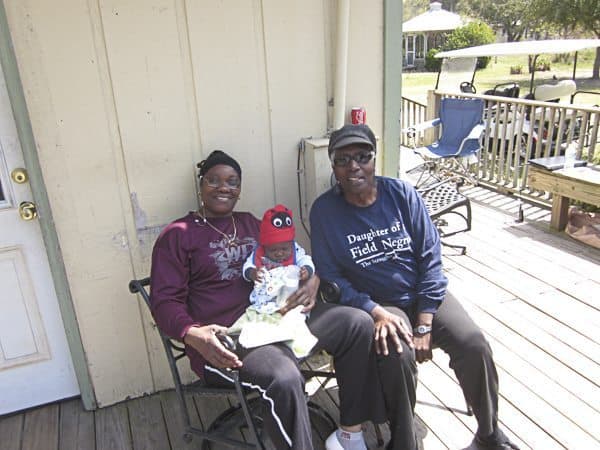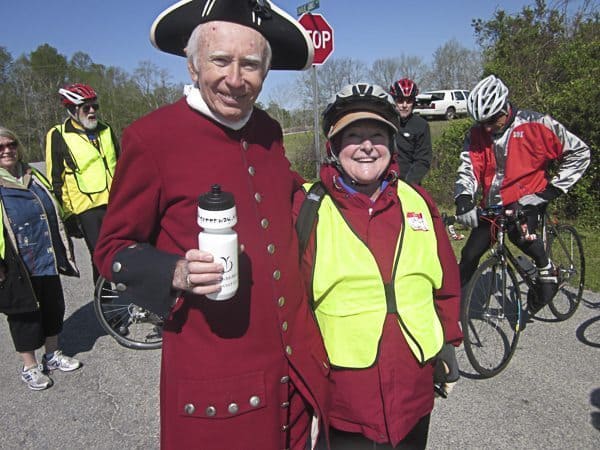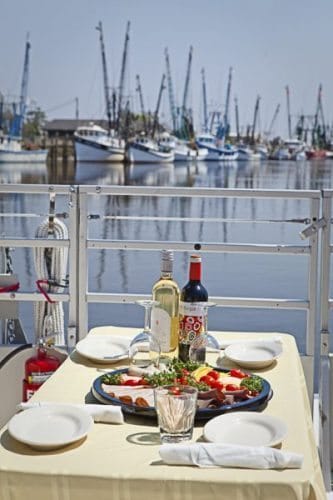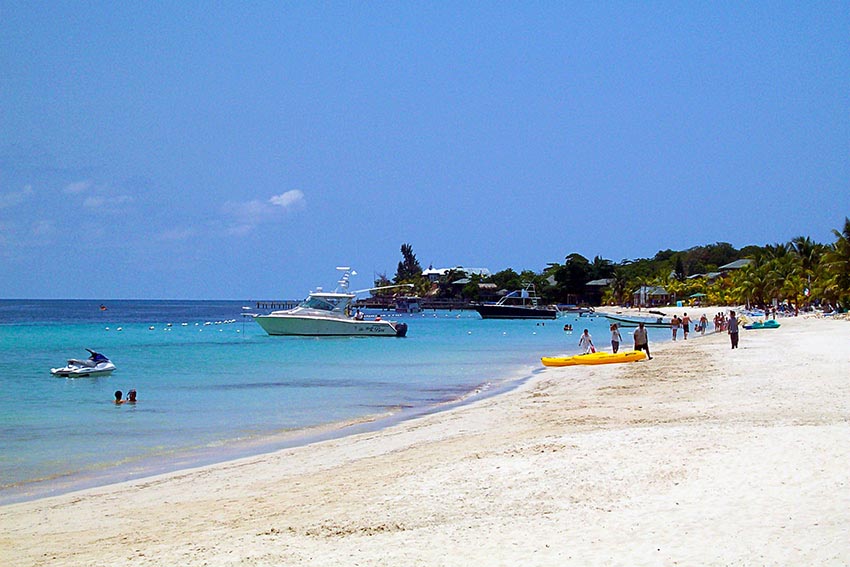
Re-cycling on the East Coast Greenway in Florida and Georgia
By Herb Hiller

Can boondock trails save the vanishing South?
Can cyclists on thousand-dollar bikes restore a fading way of life?

Factories a century ago helped lessen rural poverty in Henry Grady’s New South.
Yet, while time has tempered memories of slavery and Jim Crow, it has steadily narrowed the future for many left along the coast. For decades, once stable communities have witnessed the loss of property to developers as inexorably as to the rising sea.
It seems a bit heady to imagine that after 150 years of epochal change that bikes might usher in some next stage.
Yet, in our time, coastal places rich in West African memory share affinity with new respect for what’s authentically urban. Cyclists prefer explore-and-discover travel, where anything first seen from a car window seems invitingly unfamiliar again, and where what hasn’t yet been sloganized or televised, a gift.
These thoughts take hold after a look at a north Florida hamlet of 300, a former Gullah migrant camp that dead-ends in bush 15 miles down the road from St. Augustine. Millions each year drive to America’s oldest city. No less impressive, thousands are riding their bikes to Armstrong–because a rail-trail runs through it.
Turns out that the Gullah Geechee Cultural Heritage Corridor and the greenway overlap for 550 miles between Wilmington, North Carolina and Armstrong.
Armstrong, Florida

The corridor now favored by cyclists once carried trains to nearby lands for hauling potatoes and melons to Henry Flagler’s palatial hotel tables.
Today wide and canopied, the trail is part of a 260-mile St. Johns River to Sea Loop that’s the longest paved circular trail getting built in the South.
Once cyclists began riding through, Armstrong folks figured out how to make them feel welcomed.
They brought snacks and water to the trail crossing at Armstrong Road. They began hosting breakfasts and lunch in their community hall. They started seasonal “jump ups” with music in their park.
Last December, cyclists rode 60 miles from Gainesville to pitch tents.
Monthly rides now start and finish in Armstrong. Bike Florida runs two tours a year. Cash flow will help the community organize a grocery-café, a small lodging, a history gallery, and gain a more frequently staffed health clinic.
“Armstrong has become everybody’s favorite stop when we ride the Loop for a week,” says Bike Florida Executive Director Ron Cunningham. “You arrive like trains used to through the woods. Nobody can believe how peaceful the place is. It’s like, ‘Wow!’
In fiscal year 2012, Florida Parks reported 14,750 users on the trail through Armstrong. In 2014, 66,580
By last August, Armstrong had spurred a four-state alliance between the guardians of Gullah Geechee heritage and advocates for a 2,900-mile East Coast Greenway.
Ashantilly: Access to an Epic Culture
So do their management interests. More cyclists riding the route stir demand for getting the trail built. Cyclists, by their stays, promise to help reverse the decline of at least some communities that have gone from long isolation to the mixed blessings of gentrification.

Four of these communities, one a half-county large and so far one in each state, have become pilot projects for attracting cyclists and others as well.
Visitors find access to an epic culture that formed around the rice field labors of West Africans who, enslaved, populated the four-state coastal region.
Their families remained significantly intact because, left that way, they worked more productively. The Africans adapted their ancestral language, worshipped their gods, planted their accustomed foods, and danced to their music.
To help shore up the culture’s at-risk status, the corridor in 2006 was designated a National Heritage Area.
Even as some tourists shy from getting up close to an unfamiliar world – it’s not hawked by billboards or chain hotels — it does work for touring cyclists who travel out in the open and whose favorite questions (other than about carb loading) seem to be, “When I’m here, where am I?” “What’s going on?” “What makes the place tick?”
Here is an early report on what to expect.
Georgia’s Sapelo Island
You can drive to Armstrong, but you ride the ferry from mainland McIntosh County, Georgia to Hog Hammock on unbridged Sapelo Island. Infrequent but scheduled service provides for the 20-to-30-minute crossing of Doboy Sound. You can’t take bikes on the ferry, but you can rent them on the island. Trails run everywhere.
Midweek afternoons you ride to Sapelo with three or four youngsters who commute daily to mainland schools. Only about 45 “Saltwater Geechees” remain on the island, including some dozen of child-bearing age and their children.
Once grown, however, islanders tend toward lives ashore instead of spent fishing and gardening. Those who remain work as drivers, cooks and housekeepers for the University of Georgia Marine Institute, some at the institute-run Reynolds Mansion, a shabby-chic one-time hunting retreat that accepts only groups of at least 16 that stay at least two nights.
Visitors otherwise lodge at the tin-topped, lattice-bottomed Wallow in the Hammock. It’s an informal, well-kept six rooms with five baths. At the mansion, the food’s included. Here you prepare your own in the shared kitchen or pre-order meals from proprietors Cornelia and Julius Bailey. On cushioned comfort in the living room or wicker porch chairs, the Baileys ease you into an ancient way of life.

You hear about how fast the culture is fading. Cornelia Bailey in 2000 wrote a paean to the island way after the loss first seized her.
God, Dr. Buzzard and the Bolito Man, she called it. It did little to reverse the fade. Islanders number half what they did 15 years ago.
Islanders count success by the ones. The Baileys’ son Alfred has moved back from Yuma. He’s the first mate on the island ferry and land manager for the Marine Institute. His family will join him.
A mile from the mansion, a stunning oak allée leads to the beach, a strand of immaculate sand in a rainbow of tans. You can walk for miles and see no one; maybe a net-casting fisherman and the piles of driftwood called Boneyard Beach. Sapelo may be more peaceful today than ever.
Mainland Georgia’s McIntosh Count
Matched with Sapelo on the mainland, historic Darien, population 1,900, occupies the south end of the county, Harris Neck Wildlife Refuge the north. Across 30 north-south miles east of I-95 and US 17, the region slowly sinks into marsh, with meandering inlets that kayakers favor, and where shrimp boats navigate to docks long ago the access to first settlements.
Though trail hasn’t yet been built, cyclists roam north from Darien through traditional communities along SR 99, along a residential short section surrounding US 17, and out Shellman Bluff Road and Harris Neck Road.

You can bike the refuge along paved and unpaved roads to the largest nesting population of wood storks in America.
No places to stay up this way except interstate motels. On the other hand, restaurants are flagrantly one of a kind, woody, mostly waterfront, skilled in turning out shrimp, oysters and clams.
Chef Jerome’s Old Schoolhouse Diner sits filled with farming implements beside a patchwork of carpets that look like landfill rejects.
“Got ‘em from hotels changing out their rooms. They keep from cars from bogging down in the old sweet potato field,” says Chef Jerome.
You can bring your own beer and wine coolers to Speed’s Kitchen in Shellman Bluff – nothing speedy at all about these welded together trailers behind the shrimp docks. A retired fireman runs Sapelo Station in a vernacular old house papered in dollar bills.
For fancy, Pelican Point beside the Belleville docks sets out a seafood buffet with white cloth covered tables.
Attractions Rooted in History

Same as throughout the corridor, so-called attractions root in history. Darien once prospered on cotton, on rice and timber.
The story gets told at the Revolutionary War era site of Fort King George, at the Burning of Darien Museum (that serves as a cyclist information center), and at still fine homes around downtown squares, one of which, Open Gates, operates as a bed-and-breakfast.
Ashantilly divinely succumbs to deferred maintenance. Which is to say, it does get fixed up, but only catch as catch can, as if still by the cash-strapped William Haynes family that last lived here. Volunteers operate the printery next door that continues to hand-set beloved fonts for custom invitations.
Haynes was visionary. In 1974, he organized a conference on Man in the Landscape that today seems eerily prescient about this place-focused partnership between bicycle trails and the strengthening of coastal culture.
Darien close by its namesake river shows unexpected flair.
Along Fort King George Street sits the town’s gourmet restaurant, the Darien River House in an 1867 Victorian.
Just west on Broad Street, an investor has put in a short row of apartments and, downstairs, opened the hip Waterfront Wine & Gourmet, Darien’s favorite meet-and-greet.
Across the street, antique shops have gone in, along with the splash-colored Qué Pasa Grill & Cantina and Blondie’s Café that serves the town’s best coffee.
The Darien Waterfront Inn has transformed a one-time tabby ruins; Skipper’s, a popular bar and restaurant, follows the slope to the river to a former warehouse site. In their midst sits the Spain Building, empty, neglected, its tabby exterior with protective shutters. Fix it up and anything’s possible.
* * * * *

For travel information Armstrong, FL: floridashistoriccoast.com; McIntosh County, GA: www.visitdarien.com;
For cyclists mapping the region go to greenway.org or the smartphone app can be downloaded by searching “East Coast Greenway” in the App Store (for iPhones) or in Google Play (for Android phones).
- Armstrong, Florida on the East Coast Greenway - July 17, 2015
- Athens Georgia: A Dot of Blue in a Sea of Red - July 11, 2014
- Cherish Trains Again: Southern Railroad Travel - January 7, 2014



Interesting reading but I come away very confused. I was looking for readings on the Gullah Geechee nation and how it relates to our nearby settlement in Armstrong, Florida. Your article mentions both names but I am not sure you are talking about the Armstrong I know. I am trying to learn more about the settlement in Armstrong, Florida just outside of Palatka. You live not far from it in Deland.